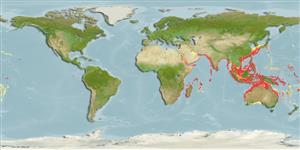Environment: milieu / climate zone / depth range / distribution range
Sinh thái học
Biển; Nước ngọt; Thuộc về nước lợ gần đáy; Di cư sông biển (để đẻ trứng) (Ref. 51243); Mức độ sâu 20 - 350 m (Ref. 58488). Tropical; 26°C - 29°C (Ref. 4959); 36°N - 35°S, 20°E - 167°W
Indo-Pacific: Red Sea and East Africa to Samoa, north to southern Japan, south to the Arafura Sea (Ref. 9819), Australia, and Lord Howe Island.
Length at first maturity / Bộ gần gũi / Khối lượng (Trọng lượng) / Age
Maturity: Lm 13.0, range 9 - 17 cm
Max length : 36.0 cm TL con đực/không giới tính; (Ref. 9710); common length : 25.0 cm SL con đực/không giới tính; (Ref. 4967)
Các tia vây lưng cứng (tổng cộng) : 11 - 12; Các vây lưng mềm (tổng cộng) : 9 - 11; Tia cứng vây hậu môn: 3; Tia mềm vây hậu môn: 7 - 10. Diagnosis: This species is distinguished by the following characters: body oblong moderately and laterally compressed, greatest body depth 2.5-3.2 times in standard length; head length 2.3-2.6 times in standard length; lower opercular spine extending well beyond the opercular flap; posttemporal bone exposed and serrate posteriorly; pectoral fin rays 13-14; gill rakers 6-8 +13-16 = 19-24; pored lateral line scales 75-100; horizontal scale rows above lateral line 13-17; caudal fin emarginate (Ref. 48274, 90102).
Found over shallow sandy bottoms, in the vicinity of river mouths. Enter estuaries and rivers (Ref. 1479, 11230, 44894, 48635), juveniles and adults are often found in freshwater (Ref. 4327). Adults in loose aggregations (Ref. 48635). Juveniles common in sandy intertidal areas; often in tidal pools. Minimum depth reported is 20 m (Ref. 12260). Found in schools (Ref. 9710). Omnivorous (Ref. 7300), feeding on fishes, insects, algae, and sand-dwelling invertebrates (Ref. 9710). Spawn in the sea and juveniles migrate into fresh water (Ref. 2847). Eggs are guarded and fanned by the male parent (Ref. 205). Produce sound (Ref. 9137). Caught on all types of inshore fishing gear including gill nets, traps, handlines, and bottom trawls and marketed fresh and dried-salted (Ref. 48274).
Eggs are guarded and fanned by the male parent (Ref. 205).
Paxton, J.R., D.F. Hoese, G.R. Allen and J.E. Hanley, 1989. Pisces. Petromyzontidae to Carangidae. Zoological Catalogue of Australia, Vol. 7. Australian Government Publishing Service, Canberra, 665 p. (Ref. 7300)
IUCN Red List Status (Ref. 130435: Version 2024-1)
Threat to humans
Harmless
Human uses
Các nghề cá: buôn bán nhỏ; Nuôi trồng thủy sản: Tính thương mại
Các công cụ
Special reports
Download XML
Các nguồn internet
Estimates based on models
Preferred temperature (Ref.
123201): 17.6 - 27.9, mean 23.7 °C (based on 917 cells).
Phylogenetic diversity index (Ref.
82804): PD
50 = 0.6250 [Uniqueness, from 0.5 = low to 2.0 = high].
Bayesian length-weight: a=0.01585 (0.01280 - 0.01963), b=3.02 (2.96 - 3.08), in cm total length, based on LWR estimates for this species (Ref.
93245).
Mức dinh dưỡng (Ref.
69278): 3.9 ±0.5 se; based on diet studies.
Generation time: 4.6 ( na - na) years. Estimated as median ln(3)/K based on 2
growth studies.
Thích nghi nhanh (Ref.
120179): Trung bình, thời gian nhân đôi của chủng quần tối thiểu là 1.4 - 4.4 năm (K=0.24).
Fishing Vulnerability (Ref.
59153): Moderate vulnerability (37 of 100).
Nutrients (Ref.
124155): Calcium = 116 [71, 223] mg/100g; Iron = 1.11 [0.71, 1.75] mg/100g; Protein = 18.4 [17.5, 19.2] %; Omega3 = 0.306 [0.183, 0.494] g/100g; Selenium = 62.8 [32.1, 121.9] μg/100g; VitaminA = 37.9 [14.6, 97.9] μg/100g; Zinc = 1.19 [0.84, 1.68] mg/100g (wet weight);
